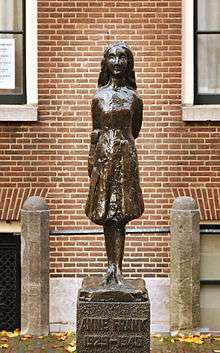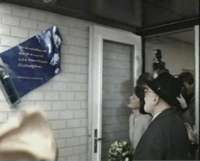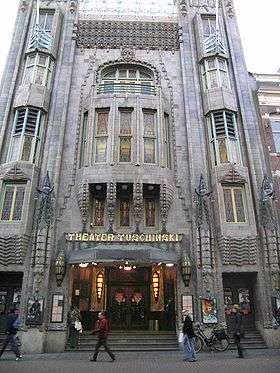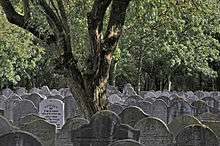History of the Jews in Amsterdam
Amsterdam has historically been the center of the Dutch Jewish community, and has had a continuing Jewish community for the last 370 years.[1] Amsterdam is also known under the name "Mokum", given to the city by its Jewish inhabitants ("Mokum" is Yiddish for "town", derived from the Hebrew "makom", which literally means "place"). Although the Holocaust deeply affected the Jewish community, killing some 80% of the some 80,000 Jews at time present in Amsterdam, since then the community has managed to rebuild a vibrant and living Jewish life for its approximately 15,000 present members. The former Mayor of Amsterdam, Job Cohen, is Jewish. Cohen was runner-up for the award of World Mayor in 2006.[2][3]
Marrano and Sephardic Jews
Permanent Jewish life in Amsterdam began with the arrival of pockets of Marrano and Sephardic Jews at the end of the 16th, and beginning of the 17th century; their first Chief Rabbi was Rabbi Uri Levi. Many Sephardi (Jews from the Iberian Peninsula) had been expelled from Spain in 1492 after the fall of Muslim Granada. Those that moved to Portugal were forced to leave in 1497, where they were given the choice between conversion to Catholicism or death penalty on the grounds of heresy.
From 1497, others remained in the Iberian peninsula, practising Judaism secretly in their homes. The newly independent Dutch provinces provided an ideal opportunity for these crypto-Jews to re-establish themselves and practise their religion openly, and they migrated, most notably to Amsterdam. Collectively, they brought economic growth and influence to the city as they established an international trading hub in Amsterdam during the 17th century, the so-called Dutch Golden Age.
In 1593, Marrano Jews arrived in Amsterdam after having been refused admission to Middelburg and Haarlem. These Jews of Converso descent were important merchants, and persons of great ability. Their expertise, it can be stated, contributed materially to the prosperity of the Netherlands. They became strenuous supporters of the contender House of Orange, and were in return protected by the Stadholder. At this time, commerce in Holland was increasing; a period of development had arrived, particularly for Amsterdam, to which Jews had carried their goods and from which they maintained their relations with foreign lands. Quite new for the Netherlands, they also held connections with the Levant, Morocco and the Caribbean Antilles.
The formal independence from Spain of the Republic of the Seven United Provinces (1581), theoretically opened the door to public practice of Judaism. Yet only in 1603 did a gathering take place that was licensed by the city. The three original congregations formed in the first two decades of the 17th century merged in 1639 to form a united Sephardic congregation.
Ashkenazim
The first Ashkenazim who arrived in Amsterdam were refugees from the Chmielnicki Uprising in Poland and the Thirty Years War. Their numbers soon swelled, eventually outnumbering the Sephardic Jews at the end of the 17th century; by 1674, some 5,000 Ashkenazi Jews were living in Amsterdam, while 2,500 Sephardic Jews called Amsterdam their home.[4] Many of the new Ashkenazi immigrants were poor, contrary to their relatively wealthy Sephardic co-religionists. They were only allowed in Amsterdam because of the financial aid promised to them and other guarantees given to the Amsterdam city council by the Sephardic community, despite the religious and cultural differences between the Yiddish-speaking Ashkenazim and the Portuguese-speaking Sephardim.

Only in 1671 did the large Ashkenazi community inaugurate their own synagogue, the Great Synagogue,[5] which stood opposite to the Sephardic Esnoga Synagogue.[6] Soon after, several other synagogues were built, among them the Obbene Shul[7] (1685-1686), the Dritt Shul[8] (1700) and the Neie Shul[9] (1752, also known as the New Synagogue). For a long time, the Ashkenazi community was strongly focused on Central and Eastern Europe, the region where most of the Dutch Ashkenazi originated from. Rabbis, cantors and teachers hailed from Poland and Germany. Up until the 19th century, most of the Ashkenazi Jews spoke Yiddish, with some Dutch influences. Meanwhile, the community grew and flourished. At the end of the 18th century, the 20,000-strong Ashkenazi community was one of the largest in Western and Central Europe.[4]
The Holocaust
Occupation of Amsterdam by Nazi Germany began 10 May 1940.[10]
Amsterdam, Holland's largest city,[11] had an estimated 75-80,000 Jews, approximately 53-57% of the country's Jewish population.[12][13] Among them was Anne Frank.
Approximately 25-35,000 of Holland's Jews were refugees.[14][15] but most of these were not in Amsterdam.[16]
Although fewer than 10 percent of Amsterdam's population was Jewish, there were two seeminly contradictory outcomes:
- a general strike against mass Nazi arrests of Jews[11][17]
- about 75-80% of the Jewish population was deported and murdered.[18][19]
Part of the Nazi plan included consolidating Holland's Jewish population into Amserterdam, prior to the "Final Solution."[11]
Canadian Forces liberated Amsterdam in the spring of 1945.
Cheider

In 1964 Adje Cohen began Jewish classes with five children in his home. This grew into an Orthodox Jewish school (Yeshiva) that provides education for children from kindergarten through high school. Many Orthodox families would have left The Netherlands if not for the existence of the Cheider : Boys and girls learn separately as orthodox Judaism requires, and the education is with a greater focus on the religious needs. By 1993 the Cheider had grown to over 230 pupils and 60 Staff members. The Cheider moved into its current building at Zeeland Street in Amsterdam Buitenveldert. Many prominent Dutch Figures attended the opening, most noteworthy was Princess Margriet who opened the new building.[20][21]
Jewish community in the 21st century
Most of the Amsterdam Jewish community (excluding the Progressive and Sephardic communities) is affiliated to the Ashkenazi Nederlands Israëlitisch Kerkgenootschap. These congregations combined form the Nederlands-Israëlietische Hoofdsynagoge (NIHS) (the Dutch acronym for the Jewish Community of Amsterdam). Some 3,000 Jews are formally part of the NIHS.[1] The Progressive movement currently has some 1,700 Jewish members in Amsterdam, affiliated to the Nederlands Verbond voor Progressief Jodendom. Smaller Jewish communities include the Sephardic Portugees-Israëlitisch Kerkgenootschap (270 families in and out of Amsterdam) and Beit Ha'Chidush, a community of some 200 members and 'friends' connected to Jewish Renewal and Reconstructionist Judaism. Several independent synagogues exist as well.[22] The glossy Joods Jaarboek (Jewish Yearbook), is based in Amsterdam, as well as the weekly Dutch Jewish newspaper in print: the Nieuw Israëlitisch Weekblad.
Contemporary synagogues

There are functioning synagogues in Amsterdam at the following addresses.
- Gerard Doustraat 238 (the Gerard Dou Synagogue)[23] (congregation Tesjoengat Israël)[24]
- Gerrit van der Veenstraat 26 (the Kehillas Ja'akov)[25]
- Jacob Obrechtplein/Heinzestraat 3 (the synagogue is called the Raw Aron Schuster Synagogue)[26]
- Lekstraat 61 (the Lekstraat Synagogue built in 1937; Charedi)[26]
- Nieuwe Kerkstraat 149 (called the Russische sjoel or Russian Shul)[26]
- Vasco da Gamastraat 19 (called the Synagogue West due to its location in the west of Amsterdam)
- There is also a synagogue present in Jewish nursing home Beth Shalom[27]
- Progressive
- Nederlands Verbond voor Progressief Jodendom (Progressive)
- Jacob Soetendorpstraat 8[28]
- Reconstructionist
- Beit Ha'Chidush (Jewish Renewal/Reconstructionist Judaism/Liberal Judaism)
- Nieuwe Uilenburgerstraat 91 (called the Uilenburger Synagoge)[29]
- Mr. Visserplein 3 (the Esnoga Synagogue)
Kashrut in Amsterdam
Kosher food in Amsterdam restaurants and shops is available.[30] There is the possibility of eating kosher in Restaurant Ha-Carmel,[31] and the well-known Sandwichshop Sal-Meijer.[32]
Jewish culture
The Joods Historisch Museum[33] is the center of Jewish culture in Amsterdam. Other Jewish cultural events include the Internationaal Joods Muziekfestival (International Jewish Music Festival)[34] and the Joods Film Festival (Jewish Film Festival).[35]
The Anne Frank House hosts a permanent exhibit on the story of Anne Frank.
Jewish cemeteries

Six Jewish cemeteries exist in Amsterdam and surroundings, three Orthodox Ashkenazi (affiliated to the NIK), two linked to the Progressive community and one Sephardic. The Askhenazi cemetery[36] at Muiderberg is still frequently used by the Orthodox Jewish community. The Orthodox Ashkenazi cemetery[37] at Zeeburg, founded in 1714, was the burial ground for some 100,000 Jews between 1714 and 1942. After part of the ground of the cemetery was sold in 1956, many graves were transported to theOrthodox Ashkenazi Jewish cemetery[38] near Diemen (also still in use, but less frequent than the one in Muiderberg). A Sephardic cemetery, Beth Haim,[39] exists near the small town of Ouderkerk aan de Amstel, containing the graves of some 28,000 Sephardic Jews. Two Progressive cemeteries, one[40] in Hoofddorp (founded in 1937) and one[40] in Amstelveen (founded in 2002), are used by the large Progressive community.
See also
References
- 1 2 NIHS General Information. Accessed July 17, 2007
- ↑ "Amsterdam closes a window on its red-light tourist trade" by Anushka Asthana, The Observer, September 23, 2007.
- ↑ "John So, Lord Mayor of Melbourne wins the 2006 World Mayor Award". www.worldmayor.com. 2006-12-05.
- 1 2 Ashkenazi Jews in Amsterdam. Edward van Voolen. Accessed July 21, 2007
- ↑ "Great Synagogue". Archived from the original on July 6, 2007. Retrieved July 21, 2007.
- ↑ Etching showing the Portuguese and High German Synagogues, at the Amsterdam City Archives
- ↑ Archived July 6, 2007, at the Wayback Machine.
- ↑ "Dritt Sjoel". Archived from the original on July 6, 2007. Retrieved July 21, 2007.
- ↑ Archived September 27, 2007, at the Wayback Machine.
- ↑ Linda M. Woolf, Ph.D. "Survival and Resistance: The Netherlands Under Nazi Occupation".
- 1 2 3 "Amsterdam".
- ↑ Dutch Census tables, 1930, 1941
- ↑ Croes, Marnix (Winter 2006). "The Holocaust in the Netherlands and the Rate of Jewish Survival'"
- ↑ Voolen, Edward van. "Askhenazi Jews in Amsterdam"
- ↑ "Administrators of the German occupied Netherlands during WW II".
- ↑ A rare photo of a round-up of Jews in 1943 in the Uiterwaardenstraat.
- ↑ lasting 3 days
- ↑ Tammes, Peter "Surviving the Holocaust: Socio-demographic Differences Among Amsterdam Jews
- ↑ The percentage of Pre-WW II Dutch Jewry surviving is estimated as under 20%
- ↑ Cheider
- ↑ van Kemenade., J (4 February 1994). "Margriet opent Cheider" (PDF). Nieuw Israelietisch Weekblad. Archived from the original (PDF) on 21 January 2016. Retrieved 23 April 2012.
- ↑ Jewish Amsterdam. Accessed July 20, 2007
- ↑ "Jewish Historical Museum - Gerard Dou Synagogue". 29 September 2007.
- ↑ "Gerarddou.org". Gerarddou.org. Retrieved 2012-12-11.
- ↑ http://www.degerrit.nl
- 1 2 3 "Synagogues and Services - Chabad Central Amsterdam - בית חב"ד מרכז אמסטרדם". www.chabadamsterdamcenter.com.
- ↑ Siraad.nl (in Dutch)
- ↑ "Beeldbank.amsterdam.nl". Beeldbank.amsterdam.nl. 1998-12-04. Retrieved 2012-12-11.
- ↑ "Jewish Historical Museum - Uilenburg synagogue". 29 September 2007.
- ↑ "NIK.nl". NIK.nl. Retrieved 2012-12-11.
- ↑ "Hacarmel.nl". Hacarmel.nl. Archived from the original on 2012-11-30. Retrieved 2012-12-11.
- ↑ "Sal-meijer.com". Sal-meijer.com. Archived from the original on 2013-01-02. Retrieved 2012-12-11.
- ↑ "Joods Historisch Museum". Jhm.nl. Retrieved 2012-12-11.
- ↑ "Joodsmuziekfestival.nl". Joodsmuziekfestival.nl. Retrieved 2012-12-11.
- ↑ "Joodsfilmfestival.nl". Joodsfilmfestival.nl. Retrieved 2012-12-11.
- ↑ "Pagina niet gevonden / Page not found -". 4 March 2016.
- ↑ "Pagina niet gevonden / Page not found -". 3 March 2016.
- ↑ "Amsterdam Diemen cemetery". Jhm.nl. Retrieved 2012-12-11.
- ↑ "Portuguese cemetery Beth Haim". Jhm.nl. Retrieved 2012-12-11.
- 1 2 "Begraafplaats Gan Hasjalom". Archived from the original on September 29, 2007. Retrieved November 18, 2007.
Sources
- This article incorporates text from the United States Holocaust Memorial Museum, and has been released under the GFDL.
Further reading
- Berger, Shlomo. "East European Jews in Amsterdam: Historical and Literary Anecdotes." East European Jewish Affairs 33.2 (2003): 113-120. covers 1630 to 1952
- Bodian, Miriam. Hebrews of the Portuguese Nation: Conversos & Community in Early Modern Amsterdam (1997), 219 pp. covers 1600 to 1699.
- Hofmeester, Karin. Jewish Workers & the Labour Movement: A Comparative Study of Amsterdam, London & Paris, 1870-1914 (2004).
- Israel, Jonathan I. "The Economic Contribution of Dutch Sephardi Jewry to Holland's Golden-Age, 1595-1713." Tijdschrift voor geschiedenis 96.4 (1983): 505-535. in English.
- Kaplan, Yosef. "The Curaçao and Amsterdam Jewish Communities in the 17th and 18th Centuries." American Jewish History 72.2 (1982): 193-211.
- Klooster, Wim. "Communities of port Jews and their contacts in the Dutch Atlantic World." Jewish history 20.2 (2006): 129-145.
- Leydesdorff, Selma; and Frank Heny. We Lived with Dignity: the Jewish Proletariat of Amsterdam, 1900-1940 (1995), 278 pp.
- Nadler, Steven M. "The Excommunication of Spinoza: Trouble and Toleration in the" Dutch Jerusalem"." Shofar: An Interdisciplinary Journal of Jewish Studies 19.4 (2001): 40-52.
- Sonnenberg-Stern, Karina. Emancipation & Poverty: The Ashkenazi Jews of Amsterdam, 1796-1850 (2000) 236 pp.
- Singer, Isidore, and Cyrus Adler, eds. (1916). The Jewish Encyclopedia. pp. 536–45.
- Snyder, Saskia Coenen. "A narrative of absence: monumental synagogue architecture in late nineteenth-century Amsterdam." Jewish History 25.1 (2011): 43-67.
- Sutcliffe, Adam. "Identity, space and intercultural contact in the urban entrepôt: The Sephardic bounding of community in early modern Amsterdam and London." Jewish Culture and History 7.1-2 (2004): 93-108.
- Tammes, Peter. "'Hack, pack, sack': occupational structure, status, and mobility of Jews in Amsterdam 1851–1941." Journal of Interdisciplinary History 43.1 (2012): 1-26. https://doi.org/10.1162/JINH_a_00336
- Tammes Peter. “Jewish-Gentile intermarriage in pre-war Amsterdam.” History of the Family 15.3 (2010): 298-315. https://doi.org/10.1016/j.hisfam.2010.05.003
- Tammes, Peter. “Residential segregation of Jews in Amsterdam on the eve of the Shoah.” Continuity and Change 26.2 (2011): 243-270. https://doi.org/10.1017/S0268416011000129
- Tammes, Peter. "Surviving the Holocaust: socio-demographic differences among Amsterdam Jews." European Journal of Population 33.3 (2017): 293-318. https://doi.org/10.1007/s10680-016-9403-3
External links
| Wikimedia Commons has media related to Judaism in Amsterdam. |
- Esnoga Website
- Jewish and Kosher Amsterdam
- Information on the NIHS
- Jewish history of Amsterdam
- Jewish Historical Museum
- United States Holocaust Memorial Museum - Amsterdam
- Amsterdam-based Jewish webshop includes info and Dutch-languages books on Jewish Amsterdam
- Story of a Dying Community: A Diary from the Amsterdam Jewish Community from the End of World War II
- The Jewish Community of Amsterdam, The Museum of the Jewish People at Beit Hatfutsot
